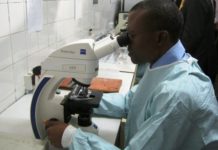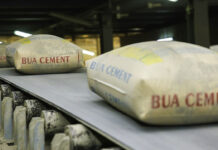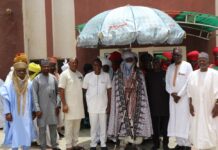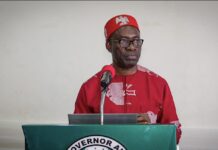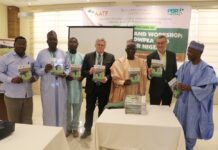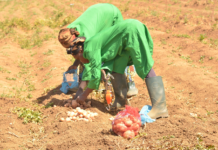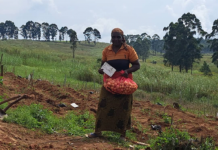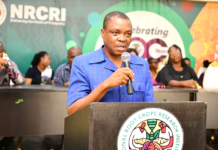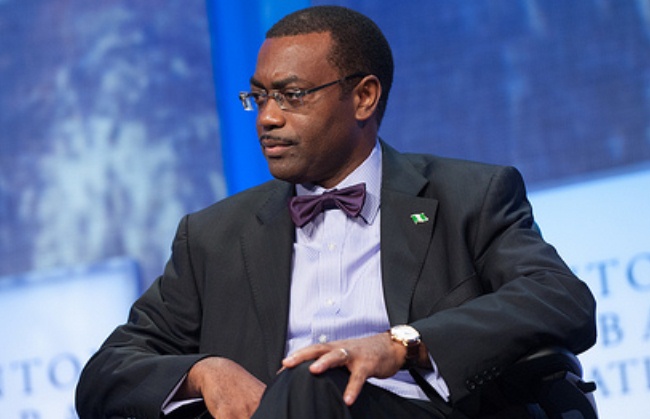Speech Delivered by
Dr. Akinwumi A. Adesina, PhD
President, African Development Bank and
World Food Prize Laureate, 2017
To African Ministers of Agriculture and Finance, at the Leadership for Agriculture Forum, held at the African Development Bank, Abidjan
November 28, 2017
- I wish to thank you for inviting me to deliver a keynote address to you on the occasion of this event on Leadership for Agriculture in Africa.
- I wish to thank the Rockefeller Foundation for continuing to support this Initiative which brings together Ministers of Finance and Ministers of Agriculture, to discuss how to transform agriculture in Africa. So, a special thank you to Mamadou Biteye, Director for Africa at the Rockefeller Foundation and Mima Nedelcovych, President of the Initiative for Global Development, for organizing this event here at the African Development Bank.
- This event is special to me, as I am very passionate about agriculture, as a former minister of agriculture myself in Nigeria. I am especially delighted to speak with you, as the 2017 World Food Prize Laureate. As this is the largest gathering of ministers of finance and agriculture since I won the World Food Prize, it is an excellent opportunity to share with you, and develop together our collective vision for agriculture in Africa.
- The challenge of addressing global food security is greatest in Africa where close to 300 million people are malnourished. It is also the only region of the world where the proportion of the population that is food insecure has increased.
- Yet, Africa holds the key for feeding the 9 billion people that will be on the planet earth by 2050. Africa sits on 65% of the uncultivated arable land left in the world, so what Africa does with agriculture will determine the future of food in the world. Therefore, more than ever before, we must help Africa to rapidly modernize its agriculture and unlock its full potential.
- The current situation where Africa spends $35 billion annually on food imports is not acceptable. If the current trend continues, Africa is estimated to spend $110 billion by 2030 on food imports. The rising food import hurts farmers in Africa. Cheap food imports decimate rural economies, displaces incomes of farmers and diverts Africa’s scarce foreign exchange away to importing what Africa should be producing very well, thereby creating lots of jobs for its people.
- There is therefore absolutely no reason for Africa to be a food-importing region. Africa has huge potentials in agriculture, but nobody eats potential!
- Unlocking that potential must start with the savannas of Africa. The savannas of Africa cover a mind-boggling 600 million hectares, of which 400 million hectares are cultivable. But just 10% of this is cultivated, a mere 40 million hectares. So massive is the potential that the World Bank called the guinea savanna zone “one of the major underutilized resources in Africa”.
- Africa’s savannas are not that different from those of Brazil. Indeed, they are better than the savannas of Brazil, because their soils are not acidic and therefore do not need liming which had to be done at massive scales in Brazil.
- Yet, while the savannas of Brazil feed the world, those of Africa cannot even feed the farmers there. Technologies, innovations, research and development, mechanization, modernization of agriculture, policy support and massive investments in infrastructure are what made the difference to turn the savannahs of Brazil and those of Northern Thailand into a food powerhouse.
- To transform its agriculture, Africa needs to make a decisive decision to develop new agrarian systems, one that combines smallholder farmers with a new dynamic generation of medium and large commercial farmers.
- Large commercial farmers played a huge role in Brazil, while in northern Thailand it was built around small farmers. One common thread in both was the rapid establishment of private sector and public policies that allowed these regions to interphase with external markets. Today, Brazil dominates global soybean production. Thailand dominates global rice and cassava markets.
- The African Development Bank’s Feed Africa strategy has launched the Transformation of the African Savannah Initiatives (TASI) to help unlock the potential of the savannas of Africa.
- The initiative will start with bringing about 2 million hectares of savannah in eight African countries – Ghana, Guinea, Democratic Republic of Congo, Central African Republic, Uganda, Kenya, Zambia, and Mozambique – under the cultivation of maize, soybean, and livestock production in optimum conditions.
- Africa must learn from the experiences that have worked elsewhere, while tailoring the interventions to the specific realities of Africa. We must ensure that small, medium scale and large-scale commercial farmers co-exist in a way that allows opportunities for all.
- Africa needs to put in place land tenure systems that make it easier to get access to land, and for smallholder farmers and their communities to have secure land rights. Traditional land tenure systems that predominate in Africa, simply perpetuates poverty and underutilization of land, and are not compatible with modern commercial agriculture that Africa needs.
- Secure land rights through land titling should be universal – most importantly, for women farmers. Properly functioning land markets will make it easier for farmers to use their lands as collateral for loans, which will help unlock commercial credit for farmers. Furthermore, the private sector needs land and it is difficult to secure this, even in the midst of so much unused or underutilized land.
- It is time to put in place land tax for unused agricultural land or underutilized agricultural land to provide incentives for faster commercialization of agriculture and unlocking its potential in Africa.
- A top priority must be to mechanize agriculture in Africa. The value added per worker in agriculture in Africa is the lowest of all regions, estimated at $ 1,990 compared to $16,000 in Eastern Asia and $6,000 in Latin America. The low productivity is due to several factors, including low levels of mechanization, limited use of high yielding seeds and fertilizers, as well as weak extension systems.
- Hoes and cutlasses, bulls or oxen, have no place any longer in African agriculture: they belong in the museums, not on the farms. We must rapidly mechanize agriculture in Africa, with low cost affordable tractors and equipment, to raise labor productivity and value added per worker to global levels.
- And we must change fast. Modern agriculture is expanding globally with digitally enabled agriculture, precision farming, hydroponics and robotics and artificial intelligence, so the farmers of the future must be fully educated. With world-class training they will take agriculture to the next level: one totally shaped by innovations.
- The future farms will be more sophisticated, in terms of use of robotics, especially with the use of drones for gathering data for farm analytics. The future farmer will most likely not be in overalls, but will be a “farming-enabler” not a physically engaged farmer. He or she would most likely be sitting in their home, sipping tea or coffee, as drones help to determine soil and weather conditions, driverless tractors sow and harvest, and analytical information from drones help to determine and regulate efficiencies in the farming cycle, including timing, level of application of pesticides.
- The farmers of tomorrow may not even need to study agriculture. Think about it, if you have access to land, and equipped with robots and drones, and intelligent tractors and combine harvesters, you’ll be a farmer. Young people will move more massively into farming. The drudgery would be gone. Farm apps will reign. Finally, farming would be really cool!
- To succeed with its agriculture, Africa needs younger and educated people in the sector. They will take agriculture as a business. They will make agriculture ‘cool.’ I fully expect the future millionaires and billionaires of Africa to come from agriculture.
- That is why the Bank is accelerating investments to get younger commercial farmers and agribusiness entrepreneurs into agriculture. To spur this, the African Development Bank has launched a youth in agriculture initiative – ENABLE YOUTH – to develop the next generation of Agripreneurs for Africa. In 2016, we invested $800 million in this initiative for 8 countries. In 2017, we will reach 15 countries. Over the next ten years, the Bank will invest $15 billion to develop new youth agriculture entrepreneurs.
- That is why I am so delighted to devote part of my $250,000 World Food Prize cash award towards the establishment of the World Food Prize Global Youth Institute for Africa! The institute will support new generation of agricultural scientists and innovators across Africa, with Borlaug-Adesina Fellows, who like you all, will be the next generation of hunger fighters.
- Agricultural technologies exist that can help Africa feed itself and unlock its potential in contributing to feeding the world. The challenge is how to take these technologies to scale to reach tens of millions of farmers.
- Take the case of rice. The release of the New Rice for Africa has changed the opportunities for raising productivity of rice. As minister of agriculture in Nigeria in 2011-2015, I introduced these varieties to farmers at scale and introduced national policy of dry season farming to complement main season production. Nigeria reached over 6 million farmers with the new rice varieties within four years and this helped to dramatically raise rice production to achieve 80% of national rice paddy needs.
- Cassava varieties exist with yield potential of 80 tons per hectare, tissue culture bananas exist yielding over 40 tons per ha compared to 15 tons farmers currently achieve.
- Biotechnology and genetic engineering will help Africa to address hitherto intractable challenges in food production, including droughts, pests and diseases. Water efficient maize for Africa now exists that can give 4 tons per ha under drought conditions surpassing existing commercial varieties by 56%.
- Africa’s food security is under a huge threat now with the Fall Army Worms that are devastating farms. It is estimated that 13.5 million MT of maize is under threat, some 20% of Africa’s maize production, with projected loss of $3 billion. CABI estimates that over $13 billion of all food crops in Africa could be lost this year due to the Fall Army worms.
- Yet, we know what to do. We just need to deploy the right technologies and extension information across agro-ecological zones and countries. Yes, we have countries, but pests do not take visas and they visit countries without borders. So, our approach must be regional, not national.
- To take agricultural technologies to scale of tens of millions of farmers across Africa, the African Development Bank and its partners have developed “Technologies for African Agricultural Transformation (TAAT)”.
- TAAT is a new regional technology delivery infrastructure for agriculture, linking countries across agro-ecological zones. For example: it will make it possible to take maize technologies across the maize belt, rice technologies across the rice belt, cassava technologies across cassava belt, and cotton across the cotton belt. So, focus is not on national boundaries, but agro-ecological zones that cut across countries. By so doing, TAAT hopes to maximize regional spillover effects from technical change.
- TAAT has as a goal to help produce 120 million MT of additional food and lift 40 million Africans out of extreme poverty and malnutrition.
- TAAT is a transformative and landmark partnership The African Development Bank, World Bank, AGRA and Bill and Melinda Gates Foundation and the Rockefeller Foundation intend to mobilize $ 1 billion to help scale up technologies across Africa. It is the biggest consolidation of efforts to accelerate agriculture technology uptake in Africa.
- TAAT will help to break down decades of national boundary focused seed release systems. What that means is that instead of a seed company having to test and release varieties only after testing for four years in a country, then four years in another (which could mean 40 years to just reach 10 countries), that will be done once across the zone, using this regional technology delivery infrastructure platform. Seed companies will have regional business investments, not just national ones. That will be revolutionary and will open up regional seed industry and markets.
- Our plan is for TAAT to be done through a collectively agreed central delivery platform, coordinated by the International Institute for Tropical Agriculture, with national, regional and international agricultural research centers.
- To date, 25 African countries have written letters to confirming interest and readiness to participate in TAAT, to help transform their agriculture. This shows the extensive consultations that have taken place and the solid buy in by governments.
- The African Development Bank is discussing this now with our Board and hope that once approved we can begin the task of really taking agricultural technologies to scale.
- African farmers must get strong policy support to accelerate the uptake of these new technologies. To unlock the potential of agriculture, African governments must develop farmer-centric public policies that accelerate uptake of agricultural technologies.
- That’s what I did as Minister of agriculture in Nigeria, using mobile phones to deliver vouchers for farm inputs, the first of its kind in the world. The system, called electronic wallet, reached 15 million farmers with improved seeds and fertilizers. Over four years the system allowed Nigeria to expand its food production by an additional 21 million MT of food.
- The e-wallet system is now being used in other parts of the world. We are now scaling this up to some 30 African countries, from the African Development Bank.
- Farmers and agribusinesses need access to financing. Of critical importance is access to long-term finance for the private sector and farmers, which will allow for greater investments in equipment, machinery, irrigation and agro-processing facilities.
- The challenge has always been the lack of interest in commercial banks to lend to agriculture, due mainly to risks. However, what is most limiting are perceived risks, not the real risks.
- We have successful approaches to address this issue very well. From my earlier work, I led efforts to design and scale up the de-risking of commercial banks across several African countries. Using risk-sharing facilities in Kenya, Ghana, Mozambique and Uganda, we leveraged $100 million from Africa’s largest commercial bank, Standard Bank into agriculture; as well as $50 million for farmers from the Equity Bank in Kenya.
- I took the lessons to scale in Nigeria and helped design the NIRSAL facility in Nigeria, to de-risk all commercial banks in the country to lend to the agriculture sector. We successfully set up a $350 million risk sharing facility with the Central Bank of Nigeria, to leverage $3.5 billion in lending towards the agriculture sector. NIRSAL has become a huge success with a repayment rate of 99%. Today, NIRSAL is a stand-alone non-bank financial institution.
- Now we must go to scale across Africa. The African Development Bank will support national efforts to de-risk lending by commercial banks to agriculture, building on the successes of prior efforts. We expect to support such efforts in 30 African countries, and have already started in Benin, Togo, Liberia and Ghana.
- We must address the high food losses in Africa. Too much food also goes to waste in Africa. The volume of wasted food is enough to feed 300 million people. So, just eliminating the food losses can more than feed them all. Yet, the major food processing companies in Africa are located in the urban areas, far from zones of food production. Part of the challenge, of course, is the lack of enabling infrastructure in rural areas. We must do a better job in reducing food losses along the food chain, improve food distribution and target nutritious food supplies to poorer households.
- We must address Africa’s huge challenge of malnutrition and stunting. About 58 million children in Africa under the age of 5 years are too short for their age (stunted); about 14 million weigh too little for their height (wasted) and 10 million are overweight. These are very disturbing numbers. UNICEF has estimated the annual cost of under nutrition in sub-Saharan Africa at $25 billion. Africa and Asia lose 11% of their GDP every year due to poor nutrition. The evidence is clear: boosting nutrition boosts the economy. Stunted children today leads to stunted economies tomorrow. It is that simple.
- We must therefore change how we look at the problem of malnutrition. The greatest contributor to economic growth is not physical infrastructure, but brainpower: what I refer to as “grey matter infrastructure“. That’s why the African Development Bank – working with Bill and Melinda Gates Foundation, Dangote Foundation, Big Win Philanthropy and the Global Panel on Food Systems and Nutrition – has launched the African Leaders for Nutrition, to help bring political accountability to address the issue of malnutrition and stunting in Africa. Our goal is to help build grey matter infrastructure in Africa.
- Investment in rural infrastructure will be critical to transforming agriculture in Africa. Farmers cannot store food, irrigation systems can’t function and food agribusiness and industries can’t operate for lack of power. Lacking power, African agro-industries operate at a high cost and become uncompetitive.
- To turn this around, African countries should develop Staple Food Processing and Agro-allied Industrial Zones. These staple food-processing zones will be enabled with infrastructure, roads, irrigation, water and electricity, which will reduce the high costs facing agribusiness and food processing companies. The companies should be provided special tax incentives for locating within staple food processing zones, close to production zones.
- Such a move will lead to industrial scale processing and value addition to all crops, livestock and fisheries products in Africa. They will create huge markets for farmers, change the face of rural economies and create massive amounts of jobs.
- Staple food processing and agro-allied industrial zones will transform rural Africa from zones of economic misery to zones of economic prosperity. These zones will also allow Africa to move into agro-industrialization and become a global player in feeding the world.
- I know when I say feeding the world, some of you may cringe and wonder how? Well, let me tell you that Africa is already contributing a significant share to feeding the world!
- Africa accounts for 75% of the world’s cocoa production. Talk of chocolates your mind goes to Belgium, Switzerland, but definitely not Côte d’Ivoire, or Ghana, which together account for 65% of total cocoa bean production. Over $100 billion is made in revenue each year from chocolates alone, but Africa receives just 2% of this.
- The reason is that Africa exports just raw cocoa beans. Africa is stuck at the bottom of the cocoa value chain, dominated, instead of dominating, in what it is the leading producer.
- This is what we must change. Africa must not be locked at the bottom of the global value chains; it must rapidly add value to what it is the world’s leading producer of.
- The African Development Bank is working on a new financing plan for cocoa sector market development and industrialization for Africa, with Cote d’Ivoire and Ghana. The focus is to help stabilize cocoa market prices, expand cocoa warehousing capacity, re-stock old plantations, address diseases and pests, support processing and value addition to cocoa at industrial scale.
- Africa accounts for over 23% of global production of coffee, with Ethiopia and Uganda, among the world’s leading producers. Africa is the highest producer of millet in the world. Africa is the highest producer of shear butter globally. Africa is the world’s highest producer of cassava. Africa is also the world’s largest producer of plantains, and number one producer of cola nuts.
- If you are like me, I like to have sesame seeds on my hamburgers. [SMILE]. Well, over 55% of the sesame you eat is produced by Africa. Africa produces 146 million tons out of the 268 million tons of cassava in the world – or 55%. Africa produces 5.4 million tons of the 5.6 million tons of cowpeas globally – or 96%. Africa produces 12 million out of the 28 million tons of millet globally – or 43%. And Africa produces 29 million tons of the 69 million tons of sorghum globally – or 42%.
- But producing raw materials is not enough. It is time for Africa to move to the top of the global food value chains, through agro-industrialization and adding value to all of what it produces.
- The secret of the wealth of nations is clear: rich nations process all of what they produce – whether in agriculture, minerals, oil and gas or services – while poor nations export raw materials.
- The price of cotton may decline, but never the price of textile and garments. The price of cocoa may decline but never the price of chocolates. The price of coffee beans may decline but never the price of brewed specialty coffee at Starbucks!
- That is why the African Development Bank has launched the largest effort in its over 50 years history to transform Africa’s agriculture. The focus is to make agriculture Africa’s largest wealth creating sector, with inclusive growth, and to take Africa to the top of the global value chains in food and agriculture.
- The Feed Africa strategy launched by the Bank has as its target making Africa self-sufficient in food within ten years, driving agro-industrial development and making the continent competitive in global food and agriculture markets.
- To push this agenda, the African Development Bank will be investing $ 24 billion in agriculture and agribusiness over the next ten years.
- We make this investment because we are taking a very good bet on Africa: that Africa has the land to feed itself. We are taking a bet that with agriculture as a business, Africa will unlock its massive agriculture potential.
- We are taking a bet that as Africa embarks on an unprecedented agricultural industrialization, it will be able to unleash a prosperity that will also lift millions out of poverty, creating new zones of prosperity all across our rural areas.
- I know that it is a bet that’s well worth it. For agriculture was Africa’s past, but in agriculture as a business lies Africa’s great and prosperous future!
- The solution is at our fingertips. The answers are in our hands. The vision can and will become a reality in our time.
- Let’s arise and feed Africa! Let’s arise and feed the world!
- Thank you very much!




